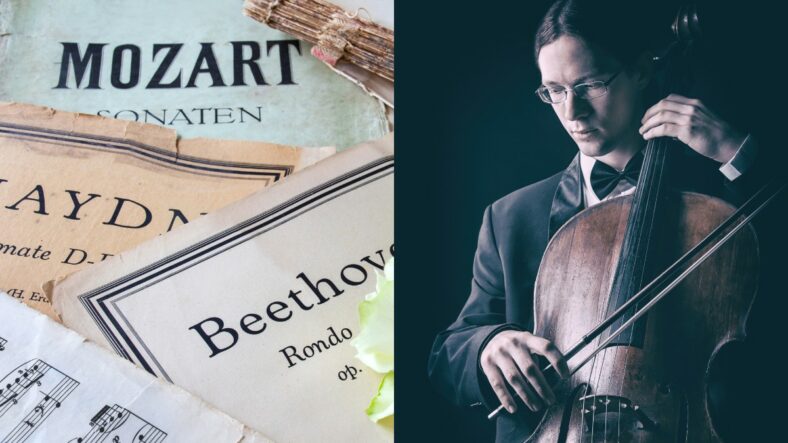What is Classical Music? (With Examples)

Classical music is a genre of Western art music characterized by its intricate compositions, emotional depth, and rich orchestration. It encompasses a wide range of styles and compositions and is still relevant today as a prominent form of music.
Classical music has evolved over centuries, beginning with medieval chants and polyphony, transitioning into the Baroque period marked by elaborate ornamentation and counterpoint, followed by the Classical period with its emphasis on clarity and balance, and culminating in the Romantic era, known for self-expression and intense emotion.
Several renowned composers and musicians have shaped the classical music world, including Wolfgang Amadeus Mozart, Ludwig van Beethoven, Pyotr Ilyich Tchaikovsky, Frederic Chopin, and Johann Sebastian Bach, each with their signature styles and iconic pieces. By appreciating the historical development and diverse subgenres of classical music, we can better identify and enjoy the intricacies and nuances each piece has to offer.
Contents
Defining Classical Music
Classical music, at its core, is a genre deeply rooted in Western musical tradition, encompassing a wide range of styles and compositions that express complex emotions and feature rich orchestration. This genre is characterized by several elements, including intricate harmonies, structured forms, and an emphasis on melody and instrumental balance. Stemming from Western European musical traditions, classical music has evolved and adapted to different eras and cultures through music history, solidifying its place in the world of artistic expression.
Some of the most defining characteristics of classical music include its harmony, counterpoint, and formal structure, which allow composers to create unique soundscapes that engage listeners and tell stories without words. Through exploring classical music and its origins, we can gain a deeper understanding of the artistic and cultural value this genre holds, as well as appreciate the breadth and depth of its influence in various forms of music across the globe.
The Historical Evolution of Classical Music
The historical evolution of classical music can be seen through various distinct periods, each showcasing unique styles and marked by notable composers that contributed to its development.
- Baroque (1600-1750): The Baroque era is characterized by elaborate ornamentation, counterpoint, and expressive harmony. Major composers include Johann Sebastian Bach, George Frideric Handel, and Antonio Vivaldi.
- Classical (1750-1820): Focused on clarity, balance, and formal structures, the Classical era brought us the sonata, symphony, and concerto forms. Key composers during this time were Wolfgang Amadeus Mozart, Franz Joseph Haydn, and Ludwig van Beethoven.
- Romantic (1820-1900): Emphasizing self-expression and emotional intensity, composers of the Romantic period sought to create more evocative music with chromatic harmonies and lush orchestration. Frederic Chopin, Pyotr Ilyich Tchaikovsky, and Richard Wagner were influential Romantic composers.
- Modernist (1900-1975): Marked by a break from traditional conventions, the Modernist period featured experimentation with new techniques, scales, and textures. Important composers include Igor Stravinsky, Claude Debussy, and Dmitri Shostakovich.
- Contemporary/Post-Modern (1975-present): This period encompasses a diverse range of styles and approaches, from minimalism to experimental music, embracing all forms of the Western classical tradition. Key figures are John Williams, Philip Glass, and Arvo Pärt.
Major Subcategories of Classical Music
Classical music encompasses a wide range of musical compositions and styles, and within this genre, there are several major subcategories to explore, each offering its unique features and qualities:
- Concerto: A piece generally featuring a solo instrument, backed by an orchestra, showcasing the virtuosity of the soloist while maintaining a balance between the solo instrument and the orchestra. Examples include violin, cello, or piano concertos.
- Sonata: A composition for one or more instruments, usually in three or four movements, with contrasting tempos and moods. Often written for piano, sonatas can also feature other instruments such as violin or flute.
- Symphony: A large-scale orchestral work, typically consisting of four movements, in which an impressive range of instruments come together to create a unified sound. Symphonies often incorporate sonata form and varying levels of complexity.
- Opera: A dramatic work combining music, theatrical performance, and often dance, to tell a narrative through sung vocal lines rather than spoken dialogue. Operas involve elaborate costumes, sets, and orchestra accompaniment.
- Chamber music: A more intimate form of classical music, usually written for small ensembles like string quartets, piano trios, or wind quintets, with one musician per part. This format emphasizes collaboration and interaction between musicians.
Iconic Examples of Classical Music
Several iconic compositions from renowned classical composers have become synonymous with the classical music genre, each with its unique backstory and significance:
- Beethoven’s Symphony No. 5: One of the most famous classical compositions, Beethoven’s Fifth Symphony is known for its four-note motif, often referred to as “fate knocking at the door.” The symphony showcases Beethoven’s ability to infuse each movement with powerful emotions and dramatic flair.
- Mozart’s Eine Kleine Nachtmusik: This delightful serenade, meaning “A Little Night Music” in German, is one of Mozart’s most recognizable works. Composed as a casual piece for an evening gathering, it has become synonymous with elegance and the refined atmosphere of the Classical period.
- Tchaikovsky’s 1812 Overture: Dramatic and powerful, this iconic overture was written to celebrate Russia’s victory over Napoleon’s invading forces. Notably, the piece includes actual cannons being fired, and its rousing finale has made it a popular choice for festive events and firework displays.
- Bach’s Brandenburg Concertos: Comprising six concertos, each featuring a different set of solo instruments, this collection showcases Bach’s mastery of the Baroque concerto form. Interestingly, these concertos were initially written as a gift to Christian Ludwig, Margrave of Brandenburg-Schwedt, but their publication and eventual fame only came much later, after Bach’s death.
Gaining insight into these iconic classical compositions, their backstories, and their significance within the context of their respective eras helps deepen our appreciation of the vast landscape of classical music and the extraordinary talents of its composers.
Renowned Classical Musicians
Throughout history, numerous talented musicians have left their mark on the world of classical music, either through their exceptional skills or by making significant contributions to the genre:
- Yo-Yo Ma: This world-renowned cellist transcends musical borders, performing a varied repertoire that spans from baroque compositions to modern works. His iconic renditions of Bach’s Cello Suites have cemented his status as a premier cellist, and he has earned multiple Grammy Awards for his exceptional work.
- Lang Lang: A celebrated Chinese pianist, Lang Lang’s virtuosity and charisma have captivated audiences worldwide. He has performed as a soloist with major orchestras around the globe, and his emotionally charged and skillful renditions of classical favorites have drawn attention to his unique approach.
- Joshua Bell: A leading American violinist, Bell is celebrated for his enchanting lyricism and stunning technique. He has performed with major orchestras and served as a soloist in some of the world’s most prestigious concert halls. One of his most famous performances is the 1993 recording of the Tchaikovsky Violin Concerto in D Major.
- Diana Damrau: Regarded as one of the leading sopranos today, Damrau has made a name for herself in opera houses around the world, known for her captivating dramatic presence and striking vocal range. Her performances in roles like Mozart’s Queen of the Night in The Magic Flute have earned her critical acclaim and numerous awards.
- Riccardo Chailly: An Italian conductor, Chailly is celebrated for his immense repertoire and collaborations with leading orchestras. Renowned for his interpretations of the works of Verdi, Brahms, and Beethoven, Chailly is currently the music director of La Scala, one of the world’s most famous opera houses.
These esteemed musicians, through their devotion to their craft and dedication to nurturing the classical music tradition, continue to inspire audiences and pave the way for future generations of talented artists.
Classical Music Today
In today’s society, classical music continues to evolve and maintain its relevance, adapting to modern culture and influencing other musical genres along the way. Here are some ways classical music remains prominent and inspiring:
- Contemporary classical music: Composers such as Philip Glass, Arvo Pärt, and John Adams have ushered in a new era of classical compositions, characterized by experimentation and a blend of diverse influences. These artists embody modern society’s penchant for innovation and keep classical music at the forefront of artistic expression.
- Film scores: Classical music has left its mark on the world of cinema as well. Notable composers like John Williams and Hans Zimmer are renowned for creating memorable and moving orchestral scores that transform the movie-watching experience, extending the genre’s impact beyond traditional concert halls.
- Cultural events and education: Classical music continues to shine in the form of concerts, operas, and ballets performed in prestigious venues worldwide. Music schools and conservatories around the globe carry on the tradition of fostering and educating new generations of musicians in the classical music genre.
- Cross-genre influence: Many popular music styles, such as jazz, progressive rock, and even hip-hop, have been influenced by classical music’s structures and conventions. This cross-pollination of musical ideas keeps classical music fresh and relevant in today’s diverse musical landscape.
Despite existing for centuries, classical music remains a vital part of our cultural fabric, continually evolving and influencing modern society while never losing its unique beauty and inherent ability to stir the emotions of all who experience it.
Conclusion
In conclusion, classical music encompasses a wide array of styles and compositions, deeply rooted in Western musical tradition and characterized by its emotional depth and rich orchestration.
From its evolution through various historical eras – Baroque, Classical, Romantic, Modernist, and Contemporary – to its diverse subcategories, including concertos, symphonies, operas, and more, classical music has shaped the world of art and culture in countless ways. Iconic composers like Mozart and Beethoven, as well as today’s celebrated musicians such as Yo-Yo Ma and Joshua Bell, have captured the hearts of audiences and showcased the timeless allure of this genre.





